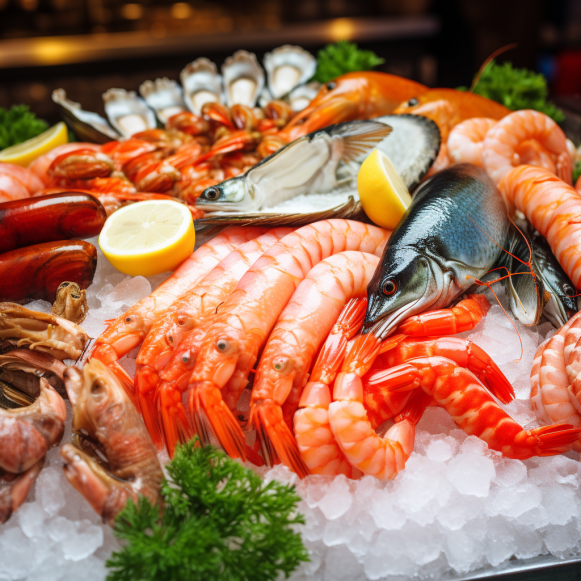From Ocean to Table: Combating Listeria Contamination in Seafood
A silent but persistent threat often goes unnoticed in the vast world of seafood: Listeria. Not just a mere bacterial contaminant, Listeria monocytogenes poses a significant health risk to seafood consumers; check out the recent outbreaks:
- In July 2023, 4 people were infected with Listeria in Norway after eating smoked fish. Reference
- August 2023, A Rapid Alert System for Food and Feed (RASFF) alert identified Listeria monocytogenes in smoked salmon from Poland. Reference
How did Listeria find its way into our favorite seafood dishes? What measures can be taken to ensure that the shrimp cocktail you're about to enjoy doesn't come with unwanted bacterial guests? As we dive deeper into the world of seafood safety, it's essential to recognize and address the silent challenges posed by Listeria monocytogenes, ensuring that every bite remains delicious and safe.
Control measures to reduce or eliminate L. monocytogenes
Good Hygiene Practices (GHP) and Hazard Analysis Critical Control Point (HACCP) systems are pivotal in ensuring seafood safety, especially in mitigating risks associated with Listeria monocytogenes. Training and education can equip producers and consumers with the knowledge to maintain safe seafood handling and consumption. While inspections can validate that these safety protocols are consistently applied, microbial testing can affirm the effectiveness of GHP and HACCP. However, it's essential to understand that more than testing seafood must be a foolproof safety guarantee.
The potential pathways for L. monocytogenes to infiltrate seafood processing facilities are diverse, given the bacterium's widespread presence. Regardless of the initial introduction, the core objective for producers should be to prevent the bacterium from establishing a foothold within the processing environment, thereby ensuring it doesn't contaminate the end product. This can be achieved through rigorous adherence to GHP and a robust HACCP plan.
Research into processes like smoked salmon production has spotlighted specific contamination hotspots for L. monocytogenes. By focusing on these areas—such as in-process product cleaning, sanitizing food-contact surfaces, delineating staff roles, enforcing stringent personal hygiene standards, and regulating visitor access—several facilities have successfully minimized L. monocytogenes presence in products and processing areas. Incorporating heat treatments, like hot steam or water at 80°C during equipment cleaning stages, has proven invaluable in curtailing L. monocytogenes in seafood processing environments.
Risk factors and hot spots
Investigations into seafood processing have highlighted that while sanitation measures seem effective in purging L. monocytogenes from equipment and production lines, the spectre of recontamination arises shortly after operations resume. L. monocytogenes can set up persistent hotspots within these facilities. A case in point: in the creation of smoked salmon, areas associated with the brining and subsequent stages have emerged as contamination zones. Advanced analyzing techniques, such as pulsed-field gel electrophoresis (PFGE), have pinpointed that the L. monocytogenes variants in the final product align more with those from the brining and slicing stages than those in the raw ingredients.
An intriguing observation was made in facilities that were well-maintained: frequent job rotations seemed to correlate with increased L. monocytogenes contamination. Insights from other industries, like meat and dairy, suggest that cleaning activities mid-production might inadvertently amplify cross-contamination.
Despite significant progress in deciphering the pathways of L. monocytogenes contamination in seafood, many questions linger. We need a deeper grasp of how L. monocytogenes binds to seafood products and machinery and the most effective strategies to eliminate these resilient bacterial communities. We can mitigate initial contamination levels through stringent manufacturing practices, meticulous cleaning, and judicious use of disinfectants and heat sterilization. However, given the nature of L. monocytogenes, expecting entirely Listeria-free products might be an aspiration rather than a guarantee, even with the most rigorous hygiene protocols.
Control L. monocytogenes in Seafood Processing
Raw Material Considerations
Interestingly, open-water fish rarely carry L. monocytogenes. However, the journey from capture to processing can introduce contamination. Vessels might harbour this bacterium due to tainted water, ice, dirty surfaces, boxes, or even contamination from human and bird guts. Fish from lakes or coastal areas often contain L. monocytogenes and are naturally at risk. Aquaculture-raised fish can be exposed through contaminated feed, agricultural run-off, or tainted sediments.
Processing Environment
The crux of L. monocytogenes control lies in pinpointing and managing direct product contamination sources. The danger escalates when food-contact surfaces are tainted, especially between food pasteurization and packaging. A suite of preventive measures tailored for seafood processing can significantly curb contamination risks. While not all measures apply universally, most facilities will find several beneficial. Prerequisite and HACCP programs can incorporate these strategies.
Retail Trade Dynamics
It's still not clear why the retail industry is susceptible to Listeria. Products bought in bulk and repackaged for sale pose contamination risks. Contamination can spring from any food-contact surface or even non-food surfaces like floors, drains, or walls. While environmental sampling isn't feasible at retail, upholding sanitary conditions and rigorous personal hygiene can slash contamination risks.
Safety hinges on storage time and conditions for ready-to-eat fish products housing L. monocytogenes. Temperature inconsistencies can heighten consumer risks. Retailers must strictly monitor storage temperatures; using "use-by-dates" can enhance control.
Overarching Control Measures
Controlling L. monocytogenes during seafood processing fundamentally leads to thorough cleaning and sanitation. Plants producing ready-to-eat (RTE) items demand heightened vigilance. A targeted hygiene and sanitation regimen can keep contamination levels minimal. Given its likely reintroduction, achieving a complete L. monocytogenes-free environment might be a lofty aim. Yet, through rigorous programs, plants can drastically reduce the odds of producing contaminated products.
Conclusion
With its countless varieties of tastes and consistencies, seafood remains a cherished component of global cuisine. However, the shadow of Listeria monocytogenes serves as a poignant reminder of the unseen challenges behind our culinary delights. From the vigilant practices of commercial establishments to the rigorous protocols set forth by regulatory bodies, every layer of the seafood industry is working in tandem to ensure that safety isn't compromised. As consumers, our role extends beyond mere consumption; it's about staying informed, understanding the risks, and appreciating the measures taken to protect our health.

